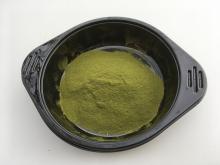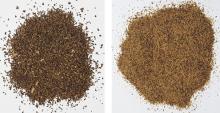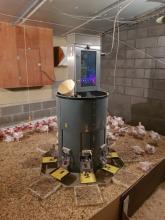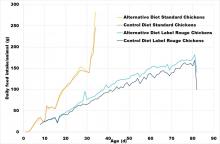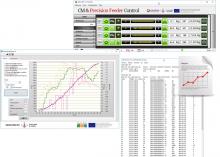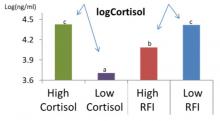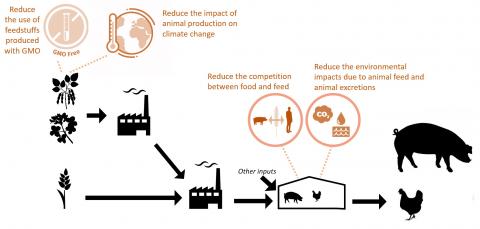Progress reports for the Feed-a-Gene project 2018-2019
Alternative feed ingredients and real-time characterisation (WP1)
WP leader: Knud Erik Bach Knudesn (Aarhus University) knuderik.bachknudsen@anis.au.dk
Production of novel feed protein from rapeseed and European grown soybeans
- A novel process for rapeseed meal improved detoxification and increased protein content from 44 to 53-57% of DM. Compared to a conventional process, desolventizing required similar energy but was less damaging to proteins.
Production of novel feed protein from green biomass
- In 2016-2017, the protein content of green biomass produced was lower than that of soybean meal, due to high ash content and inefficient protein precipitation.
- In 2017-2018, a better harvesting procedure and precipitation by heat rather than by fermentation increased protein concentration and quality.
- In vitro protein digestion of green biomass was comparable to or higher than that of soybean meal.
- Enzyme treatment during protein extraction enhanced hydrolysis in ryegrass and red clover.
Novel feed-processing technology to upgrade alternative feed ingredients
- The fine fraction of rapeseed meal resulting from fractionation was significantly richer in protein and contained less dietary fibre.
- No over-processing occurred during fractionation.
Nutritional evaluation of novel feed ingredients
- In pigs, European soybean meals obtained by extrusion-pressing or flaking-cooking-pressing without dehulling have a higher standardized ileal digestibility (SID) of amino acids than a high-quality commercial meal.
- When using non-dehulled beans, SID of amino acids and protein is lower than for the control soybean meal, which may be attributed to a relatively high trypsin inhibitor activity.
- SID of green protein materials (rye grass, red clover and lucerne) was lower than that of soybean meal. The protein concentration and digestibility of protein needs to be improved to make it an attractive alternative source of protein for pigs.
- The fine fraction of rapeseed meal resulting from fractionation had higher energy and nutrient digestibilities and resulted in a significantly higher performance (daily weight gain, feed conversion ratio) without affecting the feed intake.
- The net energy of several protein sources (corn germ meal, corn gluten feed, solvent-extracted peanut meal, dehulled sunflower meal, soybean meal, expeller-pressed rapeseed meal, solvent-extracted rapeseed meal, canola meal, cottonseed meal) was determined by indirect calorimetry.
Improvements in nutritive value by use of novel enzymes
- In broilers, inclusion of rapeseed meal reduced performance during the growing period only. There were no effects of enzyme supplementation on performance or on digesta viscosity. Inclusion of proteases and NSPases resulted in lower DM digestibility at the end of the grower phase.
- In pigs, xylanase supplementation improved daily weight gain and feed intake, and increased nutrient and energy digestibilities. It increased the acetic acid concentration in the ileum and the caecum and decreased the concentration of the lactate, iso-butyric acid and n-pentanoic acid in the colon.
New methodologies for characterisation of nutrient composition and value
- Predictive calibrations for amino acids and protein have been tested for 791 feed samples. NIR predictions of amino acids are better than estimates from protein regression. Feed mixtures are the more difficult group to predict. Models offer good accuracy and are valid for a large range of sample types.
- Predictive models for in vivo and in vitro digestibilities have been developed and tested. For the digestibility of energy, the NIR prediction was better than a commonly used in vitro method.
- Processing of green protein and rapeseed meal affected the rate and/or maximum degree of protein hydrolysis but no substantial damage on lysine was observed.
Identification of feed efficiency traits related to individual diversity (WP2)
WP leader: Alfons Jansman alfons.jansman@wur.nl
Individual feed intake and feeding behaviour in broilers and rabbits - New phenotypes to improve feed efficiency
- Data of body weight and feed intake of broilers at each visit of birds to the feeding station were collected. The algorithm of calculation of individual feed intake per visit has been established and is currently being adjusted.
- For rabbits, a device has been developed to measure individual feed intake in collective cages and is in use in further research. Traits related to feed efficiency are being studied and explored in relation to feeding behaviour.
New traits and technologies for measuring and improving digestive efficiency and gut health in pigs, poultry and rabbits
- In piglets, dietary organic acids and essential oils could improve the gastrointestinal environment, including nutrient digestion, microbiota composition, and activity of digestive enzymes.
- In pigs, predictions of OM, DM, N and energy digestibilities from faecal NIRS spectra were excellent (R² from 86 to 90%).
- In pigs, 16S rRNA microbiota information failed to predict feed efficiency.
- In rabbits, caecal microbiota explains part of the phenotypic variance of performance traits, but prediction of animal performance did not improve when microbial data were included in the model.
Nutrient metabolism related traits to improve feed efficiency
- In pigs, birthweight and protein deposition potential both affected absolute retention of body protein in the grower phase. N efficiency is however only influenced by protein deposition potential, not by birthweight.
- Young pigs with a better performance and digestive efficiency had a lower protein turnover and lower fat incorporation rates compared to older pigs. Rates of both protein and fat differed between genotypes and seemed to depend on the dietary condition.
- Pigs with a higher growth performance had a lower amino acid turnover and less fat deposition in muscle and liver. Dietary protein level altered fat metabolism.
- Individuals with a low feed efficiency had a different fermentation profile, lower microbiota biodiversity, and showed an increase of Bacteroidetes and an higher Bacteriodetes /Firmicutes ratio.
- In piglets, predictive biomarkers for digestive efficiency (fermentation metabolites, diversity index in the caecal ecosystem, specific microbiota taxa) all correlated negatively with high digestive efficiency.
Behaviour and welfare related traits influencing feed efficiency
- Results point to a relatively low correlation between behavioural data and feed efficiency traits.
- Video recording associated to deep learning was able to track individual pigs in group-housed systems with good precision. 3D cameras could obtain reliable estimates of sitting/standing behaviour.
Metabolomics to identify new traits for improvement of feed efficiency
- In pigs, urine analysis made it possible to discriminate between dietary protein regimes and between breeding value for protein deposition. Several metabolites were responsible for the separation of low and high protein deposition.
- In chickens, the ileal, caecal, and serum metabolome explained a large part of the variability of digestive efficiency. Absorbance of serum at 492 nm is strongly correlated to digestive efficiency.
- In pigs, blood biomarkers measured at an early stage were good indicators of feed efficiency.
Modelling feed use mechanisms and animal response to nutrient supply and environmental challenges (WP3)
WP leader: Veronika Halas veronika.halas@ke.hu
Digestive utilisation of feed and nutrients
- The digestive model now integrates a more detailed representation of the mechanisms of phosphorus and calcium digestibility, and is being included in the model developed in MATLAB.
Metabolic utilisation of feed and nutrients
- The pig model is able to design daily tailored feeds for precision feeding.
- The broiler model was used to evaluate different feeding strategies.
- The first version of the layer model predicts the effect of the digestible nutrient supply, including energy, amino acids, Ca and P, on egg production, and it estimates the SID amino acid, digestible Ca and P requirement of laying hens.
Accounting for environmental variability, system disturbance and robustness
- Applying the perturbation model to mycotoxin data indicate that the procedure can detect precisely the period when pigs were perturbed by mycotoxins.
- Accounting for variation among individuals in nutrient digestion and metabolism processes
- A new modelling approach for characterising variability in egg production and sow reproductive performance was developed and tested. A general method was developed to relate feed intake and body weight and efficiency of feed utilisation over time using any specified time resolution.
Delivery of a Decision Support Tool
- A version of the FeedUtiliGene Decision Support Software (DSS) containing all models has been completed.
- This version was demonstrated during a dedicated workshop and was positively evaluated by the participants.
Management systems for precision feeding to increase resilience to fluctuating environments (WP4)
WP leader: Jesús Pomar pomar@eagrof.udl.es
Building and validation of precision feeding system prototypes
- For growing pigs, the functional integration of the precision feeders and DSS was accomplished and some improvements were proposed.
- The pre-commercial precision feeding system was delivered for demonstration purposes at a commercial farm in Italy and for validation purposes at WUR.
- The DSS was able to calculate the daily formulation for each animal in the farm. Preliminary results suggest that low birthweight pigs may benefit from precision feeding.
- In broilers, experimental results were used to validate the DSS (performance, body composition).
- A first model to estimate daily nutritional requirement for energy, proteins, calcium, and phosphorus in laying hens is now available.
Demonstration activities
- A precision feeding system for growing pigs fed ad libitum has been developed and installed in a commercial pig farm in the Parma region. The software prototype integrates the controlling module, data management, and the DSS.
- A room equipped with a precision feeder prototype for growing pigs under restricted feeding is ready in the IFIP facilities for demonstration purposes.
Use of new traits in animal selection (WP5)
WP leader: Hélène Gilbert helene.gilbert@inra.fr
Genetics of components of feed efficiency and robustness indicators
- New traits for feed efficiency in growing animals (individual feed records, digestive efficiency, haematological measurements, serum absorbance) have moderate to high heritabilities and can be used for selection.
- In sows, feeding records had different heritabilities depending on the breed, and certainly on animal management.
- Differentially expressed genes after a challenge depended on the line of pigs, whereas genes were similar in layer lines.
Genetic relationships between the gut microbiota and feed efficiency
- Significant chromosomic regions were identified for individual growth, feed intake, and feed efficiency.
- The heritability estimates and significant signals detected for microbiota OTUs in pigs and rabbits validated a host control of fractions of the gut microbiota in rabbits, suggesting possible selection of some OTU abundance.
Statistical-genetic modelling of feed efficiency and robustness features
- Group measurements of feed efficiency were genetically uncorrelated with production traits. Response to selection on longitudinal ADG using indirect genetic effects showed different dynamics with time.
- Multitrait double hierarchical generalized linear models analyses suggested the existence of global robustness across traits. Prediction accuracies and biases were low for longitudinal records.
- Selection strategies to account for crossbred and genomic data for a sustainable selection for feed efficiency
- When selection was placed on FCR itself, it decreased by 7.1%, from 2.52 to 2.34 (kg/kg). Other traits that reduced FCR were: dry matter digestibility, daily feed intake, average daily gain, eating time per day, nitrogen excreted, group daily feed intake, lesion counts, Alloprevotella, joint lesions, and growth rate with social effect.
Demonstration of the value of social interactions and crossbred information in selection to improve feed efficiency
- In pigs, breeding values for indirect genetic effects (social effects) have been accumulated for testing their relationships with feed efficiency and behaviour.
- In rabbits, promising heritability estimations were obtained, but it is too early to conclude about the response to selection.
Sustainability assessment of production systems (WP6)
WP leader: Guy Garrod guy.garrod@newcastle.ac.uk
Life Cycle Assessment of proposed management systems
- Two innovative feeding strategies were assessed: (1) the use of new European protein sources to replace Brazilian soybean meal associated with deforestation and (2) individual precision feeding strategies.
- Different formulation scenarios were defined to estimate the potential of using innovative feed ingredients to reduce the environmental impact of pig and broiler production.
- Feed formulation was carried out for all scenarios in conventional pigs using four price contexts in France, Netherlands, Germany, and Spain.
- 14 scenarios for broiler production were investigated. LCA for those scenarios was conducted.
On-farm evaluation of proposed management systems
- Preliminary results of baseline analysis for pig growing/finishing production have been obtained.
Evaluation of consumer and farmer attitudes
- A survey was designed to estimate values associated with the externality attributes of animal products, and to investigate the consumer acceptability of feed technologies. The survey was undertaken in the UK and Spain.
- An interview schedule was designed to investigate the attitudes of farmers in the UK and Spain to the introduction of novel feeding strategies.
Dissemination, training and technology transfer (WP7)
WP leader: Gilles Tran (AFZ) gilles.tran@zootechnie.fr
Stakeholder events
In addition to the 3 joint Feed-a-Gene/SAPHIR meetings described previously, 3 other events were organized:
- Hands-on demonstration of the FeedUtiliGene Decision Support System (Budapest, Hungary).
- Demonstration of the precision feeding system for growing pigs (SPACE, Rennes, France).
- Stakeholder workshop on feed efficiency in rabbits (Caldes de Montbui, Spain).
Other events
Researchers participated in many other international and national events, including EPC (Croatia), JRP (France), Feed Additive Global (Netherlands), PSA Latin America (Brazil), PAGC (USA), ASESCU (Spain), Animal Microbiome Congress (Paris), PREGA (Hungart), DPC (Australia), AASV (Australia)
Publications
Feed-a-Gene researchers have made more than 150 publications, including 21 peer-reviewed papers.
A booklet of abstracts has been distributed:
Here are the 14 peer-reviewed papers published since May 2018.
- Formoso-Raferty N., Cervantes I., Sánchez J.P., Gutiérrez J.P., Bodin L., 2019. Effect of feed restriction on the environmental variability of birth weight in divergently selected lines of mice. Genetics Selection Evolution, 51: 27 DOI: 10.1186/s12711-019-0471-9
- Tusell L., Gilbert H., Vitezica Z.G., Mercat M.J., Legarra A., Larzul C., 2019. Dissecting total genetic variance into additive and dominance components of purebred and crossbred pig traits. Journal of Animal Science, 23 May 2019 DOI: 10.1017/S1751731119001046
- Piles M., Sánchez J.P., 2018. Using group records of feed intake to select for feed efficiency in rabbit. Journal of Animal Breeding and Genetics DOI: 10.1111/jbg.12395
- Garreau H., Ruesche J., Gilbert H., Balmisse E., Benitez F., Richard F., David I., Drouilhet L., Zemb O., 2018. Estimating direct genetic and maternal effects affecting rabbit growth and feed efficiency with a factorial design. Journal of Animal Breeding and Genetics, 2019, 00:1-6 DOI: 10.1111/jbg.12380
- Dukhta G., van Milgen J., Kövér G., Halas V., 2018. A growth model to predict body weight and body composition of broilers. Acta Agraria Debreceniensis, 75: 17-24 (download)
- Serviento A.M., Brossard L., Renaudeau D., 2018. An acute challenge with a deoxynivalenol-contaminated diet has short- and longterm effects on performance and feeding behavior in finishing pigs. Journal of Animal Science, 96 (12): 5209-5221 DOI: 10.1093/jas/sky378
- Van Grevenhof E.M., Vandenplas J., Calus M.P.L., 2018. Genomic prediction for crossbred performance using metafounders. Journal of Animal Science DOI: 10.1093/jas/sky433
- Seradj A. R., Balcells J., Morazan H., Alvarez-Rodriguez J., Babot D., De la Fuente G., 2018. The impact of reducing dietary crude protein and increasing total dietary fiber on hindgut fermentation, the methanogen community and gas emission in growing pigs. Animal Feed Science and Technology, 245: 54-66 DOI: 10.1016/j.anifeedsci.2018.09.005
- Le Sciellour M., Labussière E., Zemb O., Renaudeau D., 2018. Effect of dietary fiber content on nutrient digestibility and fecal microbiota composition in growing-finishing pigs. PLOS One, 13 (10): e0206159 DOI: 10.1371/journal.pone.0206159
- Beauclercq S., Lefèvre A., Nadal-Desbarats L., Germain K., Praud C., Emond P., Le Bihan-Duval E., Mignon-Grasteau S., 2018. Does lipidomic serum analysis help in the assessment of digestive efficiency in chickens?. Poultry Science, 16 October 2018 DOI: 10.3382/ps/pey483
- Velasco-Galilea M., Piles M., Viñas M., Rafel O., González-Rodríguez O., Guivernau M., Sánchez, J.P., 2018. Rabbit microbiota changes throughout the intestinal tract. Frontiers in Microbiology, 13 September 2018 DOI: 10.3389/fmicb.2018.02144
- Tallentire C.W., Mackenzie S.G., Kyriazakis, I., 2018. Can novel ingredients replace soybeans and reduce the environmental burdens of European livestock systems in the future?. Journal of Cleaner Production, 187: 338-347 DOI: 10.1016/j.jclepro.2018.03.212
- Ragab M., Piles M., Quintanilla R., Sánchez J.P., 2018. Indirect genetic effect model using feeding behaviour traits to define the degree of interaction between mates: an implementation in pigs growth rate. Animal, 12 (7): 1-9 DOI: 10.1017/S1751731118001192
- David I., Sánchez J.P., Piles M., 2018. Longitudinal analysis of direct and indirect effects on the average daily gain in growing rabbits using a structured antedependence model. Genetics Selection Evolution, 50: 25 DOI: 10.1186/s12711-018-0395-9
